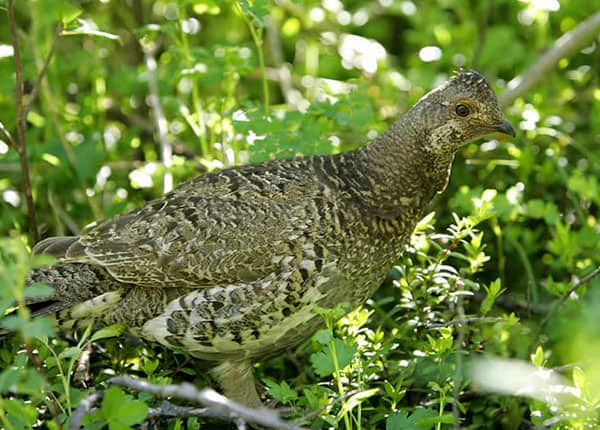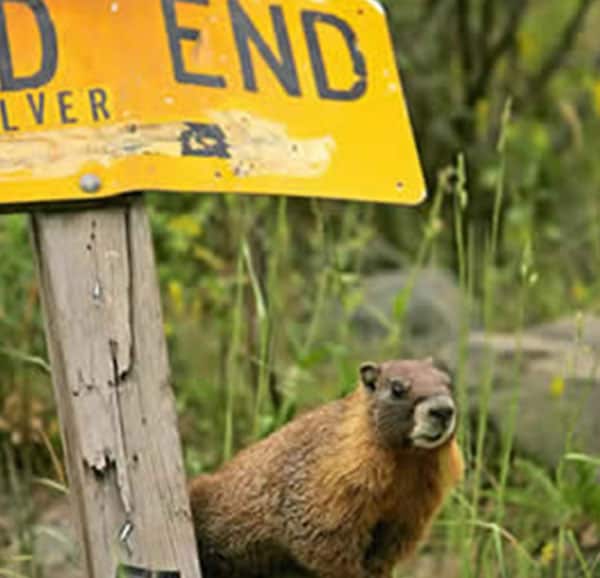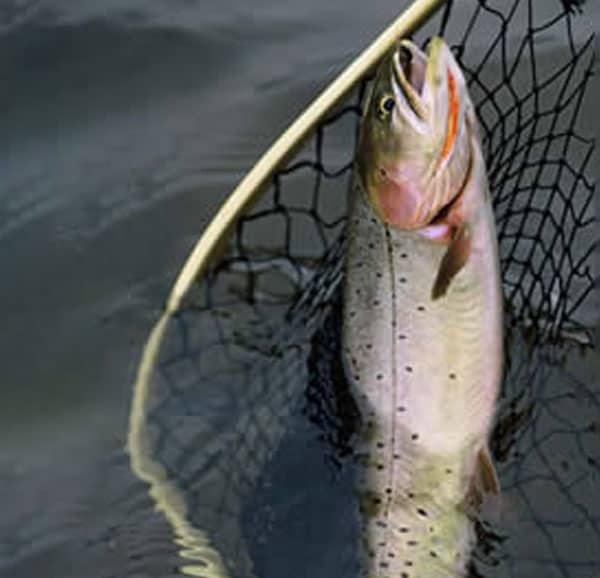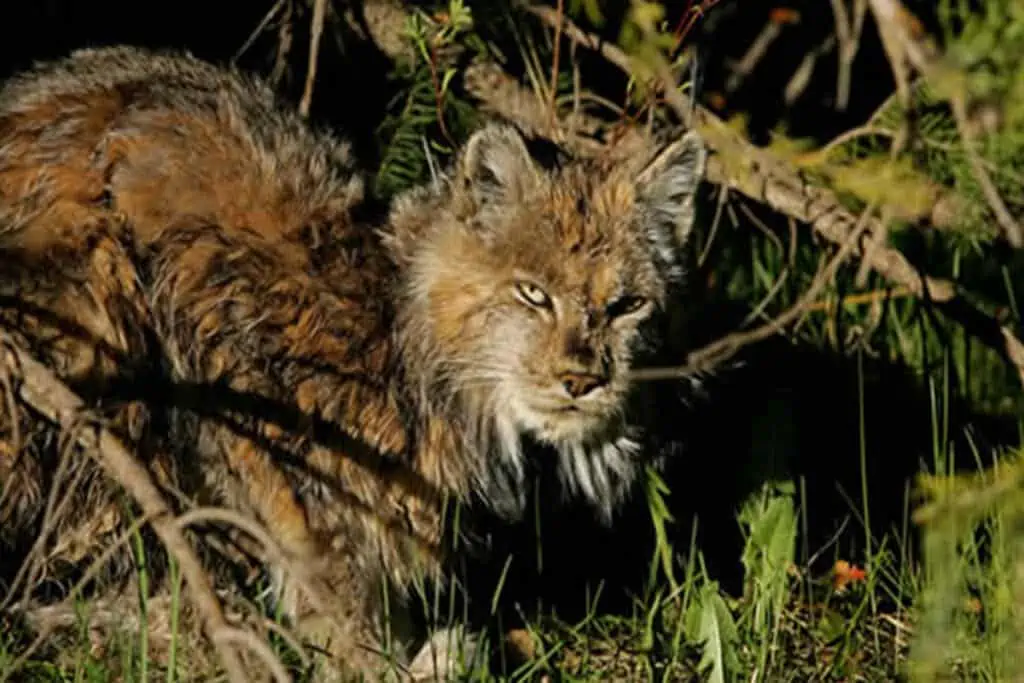MARBLE, COLORADO WILDLIFE and GEOLOGY
This Canadian lynx was released by the Colorado Division of Wildlife and made the Marble area its home.
The banner photo at the top of this page is the Elk Mountain Range surrounding the Upper Crystal River Valley. Marble is in the valley below. As you can see, it’s rugged, steep, mountainous terrain. On the south side of the valley (to the right of the photo), the mountains are capped with granitic formations from an upswelling of magma many millions of years ago. Chair Mountain, the largest mountain to the right, is 13,400 feet in elevation, and the majority of the mountain is granite. However, the lower strata of the mountain are still part of the Mancos Shale formation, and it is a crumbly formation that has many seams of coal in it. Treasury Mountain, on the east side of Yule Creek, is a giant dome of granite with a seam of marble underneath it–300 feet thick and 7 miles across. Yes, there’s a lot of marble there, and that’s why the Yule Marble Quarry is in operation. To the northeast, the Maroon Bells/Snowmass Wilderness area extends all the way to Aspen. There are several peaks in the wilderness area that are 14,000 feet or taller, including Capitol Peak, Snowmass Peak, Hagerman Peak, and the Maroon Bells. To the southeast, the rugged mountains lead to Crested Butte. Beginning on the east side of Lead King Basin, the granite and Mancos Shale gives way to the pink/red sandstone rocks of the Maroon Formation, which comprise the 14,000-foot peaks of the Maroon Bells. Hasley Basin, Frigid Air Pass, and West Maroon Pass are all comprised of the red sandstone Maroon Formation. WILDLIFE The Marble area is home to many different species of wildlife. We were formerly the wilderness outfitters in Marble, offering horseback rides, flyfishing trips, overnight pack trips, and elk and deer hunts. In one memorable week in May, as the snow was receding from the mountains and animals were out and about, we spotted a lynx that was part of the Colorado Division of Wildlife’s reintroduction program (it had a radio collar) walking through our horse pasture; a mountain lion (there were three elk kills on the mountainside across from our stables); coyotes; elk; and mountain goats on the mountain to the south.

A blue grouse posed for me on the road between Marble and Crystal
Birds are numerous in the Marble area. Songbirds such as mountain bluebirds, finches, grosbeaks, and wrens are plentiful. Blue grouse are found at elevations ranging from 8,000 feet to 12,000 feet; ptarmigan can be found at elevations above 12,000 feet. Raptors include red-tailed hawks, kestrels, merlin’s falcons, peregrine falcons, goshawks, golden eagles and occasionally bald eagles, and all manner of owls. Big game populations are healthy in the Marble area. There is a large elk herd that offers excellent hunting. Unit 43 elk tags can be purchased over the counter for second and third rifle season, and first and fourth rifle tags are fairly easy to draw. Unit 43 trophy mule deer hunting is excellent around Marble, but we suggest that you engage a guide, because it’s difficult hunting. Mountain goats range the high ridges to the south of town, on Prospect Mountain, Chair Mountain, the North Anthracite basin, and on east to the Yule Creek drainage. Bighorn sheep are found to the north, starting on Elk Mountain, the Carbonate Creek drainage, and larger herds are found on Gift Creek, Little Kline, East Creek, and on Avalanche Creek above Redstone.

Small animals are numerous, both predators and prey. I saw three pine marten one summer. Otherwise known as fishers, these are a cat-sized member of the weasel family that prey on squirrels. Their furs are prized for sable coats. There are lots of marmots (woodchucks) around Marble, preferring to dwell in rockpiles. Snowshoe hare are plentiful, as well as coyotes and fox. One of my neighbors was fond of watching the red fox from her kitchen window, and one morning she got quite a wildlife show as the lynx caught a fox, killed it, and ate it. Bears are numerous around Marble, and local residents and visitors alike are reminded to keep their trash contained. Many residents got by with lax trash-containment habits for years; in 2007, with a poor berry and oak mast crop, bears came down to town in numbers. I saw 7 bears in a two-day period in the fall of 2007. Some were in town tipping over dumpsters, and others were high in the mountains where they belong. In the winter, elk are vulnerable to dogs running at large. In January 2008, I drove into town to find a herd of elk bedded down right on the town limits, 20 yards from the main paved road. The snow was deep and they were working hard to stay alive. One or two dogs could cause enough stress to deplete an elk’s fat reserves so that it doesn’t survive the winter. The rivers and lakes around Marble are home to good populations of trout and whitefish. I’ve guided many fishing trips where my clients caught what I call the “Colorado Slam”–a German brown trout, rainbow, brook trout, and cutthroat trout, all in the same day. The Crystal River has good populations of trout, but anglers are encouraged to practice “catch and release” fly-fishing. The riverbottom is very rocky, and spinners and bait rigs tend to get snagged. Trout caught with spinners and bait have a much higher mortality rate when released. Fishing is good, but deteriorates quickly when anglers take fish home.

If wildlife is important to you, Marble is a great place to buy mountain real estate. You’ll have the opportunity to interact with wildlife on a regular basis, whether it’s watching a herd of elk cross the river, spotting a mountain goat high on the side of the mountain, or watching birds out your kitchen window. Call me, Gary Hubbell, if you’d like to walk on the wildlife side. I’ll show you some great mountain properties, cabin sites, horse properties, ski houses, and vacant land.

